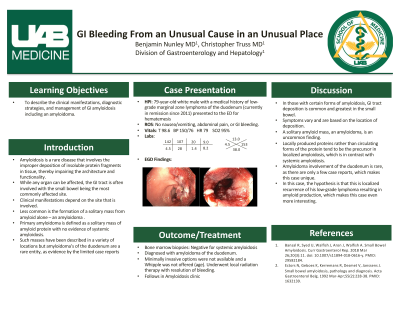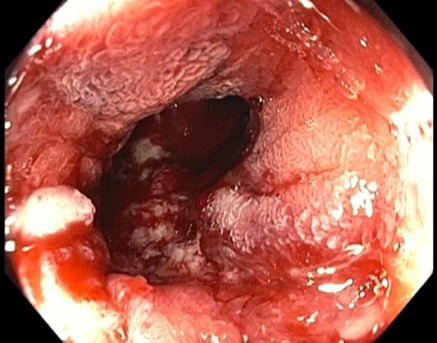Back


Poster Session B - Monday Morning
Category: GI Bleeding
B0331 - GI Bleeding From an Unusual Cause in an Unusual Place
Monday, October 24, 2022
10:00 AM – 12:00 PM ET
Location: Crown Ballroom

Has Audio
- BN
Benjamin Nunley, MD
University of Alabama at Birmingham
Birmingham, Alabama
Presenting Author(s)
Award: Presidential Poster Award
Benjamin Nunley, MD1, Tyler Colvin, MD1, Christopher Truss, MD2
1University of Alabama at Birmingham, Birmingham, AL; 2UAB, Birmingham, AL
Introduction: Amyloidosis is a rare disease that involves the abnormal deposition of insoluble protein fragments in tissue resulting in impaired functionality and architecture. Deposition is usually systemic with variable involvement of different organs resulting in a wide range of clinical manifestations. Less common is the formation of a solitary mass from amyloid alone – an amyloidoma. Primary amyloidoma is defined as a solitary mass of amyloid protein with no evidence of systemic amyloidosis. Such masses have been described in a variety of locations but amyloidoma’s of the duodenum are a rare entity, as evidence by the limited case reports.
Case Description/Methods: A 79-year-old white male with a medical history of low-grade marginal zone lymphoma of the duodenum (currently in remission) presented to the ED for hematemesis. He had no preceding nausea/vomiting, abdominal pain, melena, or hematochezia. He was hemodynamically stable with an initial hemoglobin of 13, which downtrended to 10.7. Other labs were normal. Findings on physical exam were unremarkable. Upper endoscopy revealed a large, circumferential, partially-obstructing mass beginning in the duodenal bulb and extending into the 2nd portion of the duodenum. The mass was very friable with active oozing on contact. The rest of the exam to the proximal jejunum was normal. Biopsies from the duodenal mass came back as extensive mucosal and submucosal amyloid deposition, ulceration/granulation tissue, and fibroinflammatory features without evidence of lymphoma. It stained positive for Congo red. Bone marrow biopsy was done during the admission with no evidence of systemic amyloidosis. His bleeding subsided and he was discharged home with follow up in Amyloidosis clinic for further management.
Discussion: In those with certain forms of amyloidosis, GI tract deposition is common and greatest in the small bowel. Symptoms vary and are based on the location of deposition. A solitary amyloid mass, an amyloidoma, is an uncommon finding. Locally produced proteins rather than circulating forms of the protein tend to be the precursor in localized amyloidosis, which is in contrast with systemic amyloidosis. Amyloidoma involvement of the duodenum is rare, as there are only a few case reports, which makes this case unique. It is also hypothesized that he has recurrence of his localized low-grade lymphoma resulting in amyloid production, which makes this case even more interesting.

Disclosures:
Benjamin Nunley, MD1, Tyler Colvin, MD1, Christopher Truss, MD2. B0331 - GI Bleeding From an Unusual Cause in an Unusual Place, ACG 2022 Annual Scientific Meeting Abstracts. Charlotte, NC: American College of Gastroenterology.
Benjamin Nunley, MD1, Tyler Colvin, MD1, Christopher Truss, MD2
1University of Alabama at Birmingham, Birmingham, AL; 2UAB, Birmingham, AL
Introduction: Amyloidosis is a rare disease that involves the abnormal deposition of insoluble protein fragments in tissue resulting in impaired functionality and architecture. Deposition is usually systemic with variable involvement of different organs resulting in a wide range of clinical manifestations. Less common is the formation of a solitary mass from amyloid alone – an amyloidoma. Primary amyloidoma is defined as a solitary mass of amyloid protein with no evidence of systemic amyloidosis. Such masses have been described in a variety of locations but amyloidoma’s of the duodenum are a rare entity, as evidence by the limited case reports.
Case Description/Methods: A 79-year-old white male with a medical history of low-grade marginal zone lymphoma of the duodenum (currently in remission) presented to the ED for hematemesis. He had no preceding nausea/vomiting, abdominal pain, melena, or hematochezia. He was hemodynamically stable with an initial hemoglobin of 13, which downtrended to 10.7. Other labs were normal. Findings on physical exam were unremarkable. Upper endoscopy revealed a large, circumferential, partially-obstructing mass beginning in the duodenal bulb and extending into the 2nd portion of the duodenum. The mass was very friable with active oozing on contact. The rest of the exam to the proximal jejunum was normal. Biopsies from the duodenal mass came back as extensive mucosal and submucosal amyloid deposition, ulceration/granulation tissue, and fibroinflammatory features without evidence of lymphoma. It stained positive for Congo red. Bone marrow biopsy was done during the admission with no evidence of systemic amyloidosis. His bleeding subsided and he was discharged home with follow up in Amyloidosis clinic for further management.
Discussion: In those with certain forms of amyloidosis, GI tract deposition is common and greatest in the small bowel. Symptoms vary and are based on the location of deposition. A solitary amyloid mass, an amyloidoma, is an uncommon finding. Locally produced proteins rather than circulating forms of the protein tend to be the precursor in localized amyloidosis, which is in contrast with systemic amyloidosis. Amyloidoma involvement of the duodenum is rare, as there are only a few case reports, which makes this case unique. It is also hypothesized that he has recurrence of his localized low-grade lymphoma resulting in amyloid production, which makes this case even more interesting.

Figure: Amyloidoma in duodenal bulb extending into the second portion of the duodenum
Disclosures:
Benjamin Nunley indicated no relevant financial relationships.
Tyler Colvin indicated no relevant financial relationships.
Christopher Truss indicated no relevant financial relationships.
Benjamin Nunley, MD1, Tyler Colvin, MD1, Christopher Truss, MD2. B0331 - GI Bleeding From an Unusual Cause in an Unusual Place, ACG 2022 Annual Scientific Meeting Abstracts. Charlotte, NC: American College of Gastroenterology.

